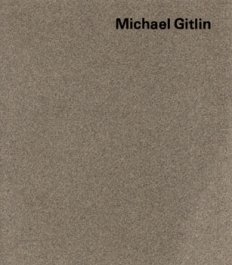Texts: Israel Museum 1977
Works: 1974–77
Israel Museum, Jerusalem, Billy Rose Pavilion, August–September 1977
In English the word ‘work’ draws no distinction between ‘creation’ and ‘work’. In Hebrew, we prefer use of the term ‘creation’ to ‘work’. This may be because we are accustomed to looking at the finished product without considering the process by which it was achieved or the tools and materials used by the artist. With Gitlin, this distinction does not exist. The finished product—the work—is a result of activity that preserves its full meaning and presence in the work itself. Between the basic premise and the final product there is a process of physical activity similar to that involved in the making of a sensitive drawing on paper. Not only is the form defined and the surface broken down into its formal components, but the activity itself also has an expressive quality of its own and is an extension of the movement of the hand and the tool it wields. This process tests the logic that connects the basic premise, the plan of execution (the conceptual aspect) with its concrete realization (the perceptual aspect). Various critics have commented on the dual nature of Gitlin’s work, on the difficulty of placing it between drawing and sculpture. Indeed, the meaning of the action of the axe or the saw on the wood is in principle no different from that which a line in pencil gives to the paper, and the difference in the material used is sufficient to explain the difference in the tools. However, the way each wood piece is made also dictates the placement and mutual relationship between the severed components in the actual space (wall, or wall and floor) which is the space occupied by the sculpture.
Drawing and sculpture—a finished product that simultaneously contains a basic premise and the process of its realisation. The work, which is presented to us in all its simplicity, is many-faceted in its meaning. It recalls Action Painting and Minimalism, and it combines the treatment of material in drawing (folding and tearing) with conceptual attitudes in regard to space (Carl Andre) and perception (Richard Long). But over and above all this, beyond definitions and formulas, the work poses questions concerning the meaning of an object in relation to space: the object and the space define each other. Because of their absolute mutual dependence they are perceived by us as the concrete components of a situation which in other circumstances would have been seen as abstract.
Yona Fischer
Notes
The plywood sheet from which each piece in the “4’ x 8’ Series” (1974–77) is made, is a standard commercial unit. The dimensions of the various components of each piece, taken from the original sheet, are personal. The measurements of the original sheet serve as a basic reference point and dictate the location of these components in the room. All the works—not only those in the 4’ x 8’ Series—are each made from one wood or plywood unit. The breaking of the unit is done with an axe. Particles of wood at the breaking point are lost so that, physically, one cannot ‘return’ the components and make up the original unit.
Michael Gitlin


